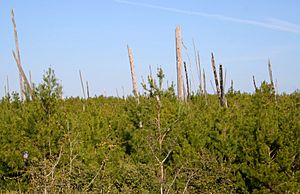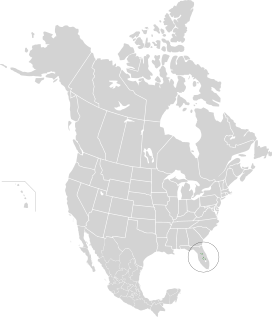Florida scrub facts for kids
Quick facts for kids Florida sand pine scrub |
|
|---|---|

Juniper Prairie Wilderness, Ocala National Forest
|
|
 |
|
| Ecology | |
| Realm | Nearctic |
| Biome | Temperate coniferous forest |
| Borders | Southeastern conifer forests |
| Bird species | 173 |
| Mammal species | 43 |
| Geography | |
| Area | 3,900 km2 (1,500 sq mi) |
| Country | United States (Florida) |
| Conservation | |
| Conservation status | Critical/endangered |
| Global 200 | No |
| Habitat loss | 33.498% |
| Protected | 34.94% |
The Florida sand pine scrub is a special kind of forest in Florida, USA. It's a 'subtropical' forest, meaning it's warm most of the year, and it's considered an 'ecoregion' – a large area with unique plants and animals. You'll find it on sandy hills and ridges, both near the coast and further inland. This area is home to plants that can live in dry places (called 'xeromorphic' plants), mostly made up of shrubs and small oak trees that stay green all year.
The soil here is very sandy and doesn't hold much water or nutrients. This means that even though Florida gets rain, the scrub feels like a dry, desert-like place for plants. Big wildfires don't happen very often here. Most of the rain (about 135 centimeters or 53 inches) falls during the summer.
Sadly, this unique habitat is in danger because of new homes, businesses, and farms. The biggest remaining part of the scrub is found in and around the Ocala National Forest. Other important areas include the Lake Wales Ridge National Wildlife Refuge and the Archbold Biological Station near Lake Placid. The Archbold Biological Station has about 20 square kilometers (about 7.7 square miles) of scrub and scientists there study its amazing plants and animals.
Contents
Amazing Plants of the Florida Scrub
The Florida scrub is home to many plants and animals found nowhere else on Earth. Scientists believe there are about 40 plant species, 4 types of vertebrates (animals with backbones), and at least 46 kinds of arthropods (like insects and spiders) that live only here.
Florida Peninsula Inland Scrub Plants
This is the main plant community that gives the ecoregion its name.
- Sand pines (Pinus clausa) form the top layer, or 'canopy', of the forest.
- Common plants growing below include sand live oak (Quercus geminata), myrtle oak (Q. myrtifolia), sandhill oak (Q. inopina), and Chapman oak (Q. chapmanii).
- You might also see Florida rosemary (Ceratiola ericoides), scrub palmetto (Sabal etonia), and saw palmetto (Serenoa repens).
- Other interesting plants are garberia (Garberia heterophylla), fetterbush lyonia (Lyonia lucida), and rusty staggerbush (L. ferruginea).
- Look closely on the ground for cup lichens (Cladonia species).
- Even some types of holly (Ilex opaca var. arenicola) and American olive (Osmanthus americanus var. megacarpus) grow here.
- You might also spot flag-pawpaw (Asimina obovata), silk bay (Persea humilis), Adam's needle (Yucca filamentosa), and eastern prickly pear (Opuntia humifusa).
Longleaf Pine Sandhill Plants
Next to the scrub, you often find longleaf pine sandhills. These areas have tall longleaf pines (Pinus palustris) growing on very sandy hills that drain water well. These forests need frequent fires to stay healthy.
- Turkey oak (Quercus laevis) is common in the layer of plants below the pines.
- On the ground, you'll mostly see pineland threeawn (Aristida stricta), a type of grass.
Oak Dome and Hammock Plants
Oak domes and hammocks are small, thick patches of evergreen oak trees. They grow in slightly lower areas or on small hills. These forests look very different from the longleaf pine areas around them.
- In wetter spots, you'll find southern live oak (Quercus virginiana), sand laurel oak (Q. hemisphaerica), and American persimmon (Diospyros virginiana).
- The plants growing below these trees are not very dense, but you might see trumpet creeper (Campsis radicans) and greenbriers (Smilax species).
- In drier spots, common trees are sand live oak (Quercus geminata) and southern live oak (Q. virginiana).
- You'll also see longleaf pine (Pinus palustris), pineland threeawn (Aristida stricta), and southern dawnflower (Stylisma humistrata).
Highlands Freshwater Marsh Plants
Highlands freshwater marshes are wet, grassy areas found in shallow valleys, old lake beds, or along the edges of lakes. The types of plants here change depending on how deep the water is.
- Deep water areas have plants that float or are completely underwater.
- In water about a meter deep, you'll find tall, single types of plants growing thickly, like bulrush (Typha latifolia), pickerelweed (Pontederia cordata), and American lotus (Nelumbo lutea).
- Shallow areas that are only wet during the rainy season have more grasses, such as maidencane (Panicum hemitomon) and southern cutgrass (Leersia hexandra).
- These marshes can change over time due to how water flows and drains. The soil can be mucky, loamy, or sandy, but it usually has standing water for much of the year. These areas are sometimes called meadows or prairies.
Nonriverine Basin Swamp Plants
Nonriverine basin swamps are large, wet areas that flood with water during certain seasons. They are found away from rivers.
- These swamps are often forested with trees like bald cypress (Taxodium distichum), swamp tupelo (Nyssa biflora), and sometimes slash pine (Pinus elliottii).
- Common shrubs in these swamps include buckwheat tree (Cliftonia monophylla), swamp cyrilla (Cyrilla racemiflora), laurelleaf greenbrier (Smilax laurifolia), and fetterbush lyonia (Lyonia lucida).
Animals of the Florida Scrub
The Florida scrub is home to many unique animals. Some of the most well-known include:
- The Florida scrub jay (Aphelocoma coerulescens) is a special bird found only in the Florida scrub.
- The Florida mouse (Podomys floridanus) is another animal that lives only in this ecoregion.
- Reptiles like the sand skink (Neoseps reynoldsi), bluetail mole skink (Plestiodon egregius lividus), Florida scrub lizard (Sceloporus woodi), and Florida worm lizard (Rhineura floridana) also call the scrub home.
- The gopher tortoise is a very important animal here. It digs burrows that many other animals use for shelter, making it a 'keystone species' because it helps so many other creatures survive.
Images for kids
See also
 In Spanish: Breñal de Florida para niños
In Spanish: Breñal de Florida para niños


